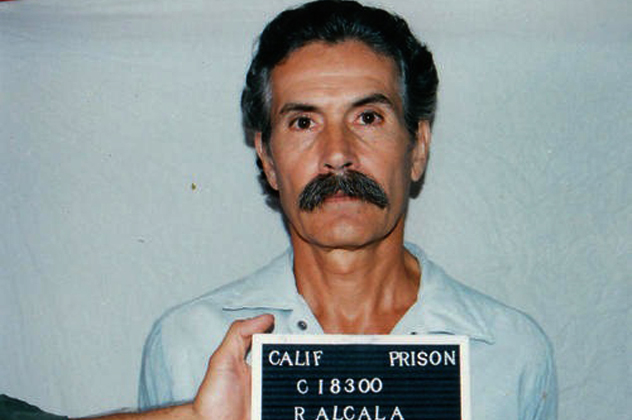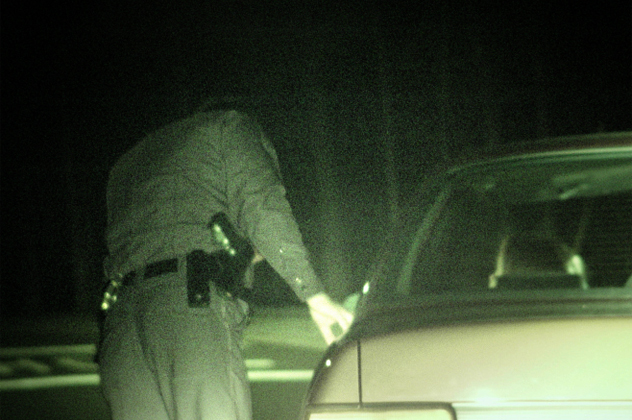In some cases, though, there are those who are fortunate enough to escape the clutches of madness. Their stories serve as lessons in survival that we can all learn from, lessons that could very well save a life.
10Maria Viricheva
Three months pregnant and unmarried, 19-year-old Maria Viricheva was working as a saleswoman at the time of her encounter with one of Russia’s most notorious serial killers—Alexander Pichushkin, also known as the Chessboard Killer. She was new at her job and had been set up with it by her boyfriend, who was also the father of her child. Earlier that day, the two had gotten into an argument, and afterward she found herself distraught in a metro station in Moscow. Pichushkin spied Maria and, noting her obvious state of despair, struck up a conversation with her. Maria, desperate and alone, welcomed the company. Hearing of her situation, Pichushkin offered her a chance to earn some additional money, telling her that he had stashed some stolen cameras in a well in nearby Bittsevsky Park and that he would give her some to sell. Even though it was late in the evening, Maria, not even knowing if her job would be there for her in the morning anyway, agreed to go with him to retrieve the cameras. When they arrived at the spot, Pichushkin lifted the cover from the well and told her to look inside. As she did so, he quickly snatched her up and threw her in. She clung to the sides of the well to avoid falling, but Pichushkin grabbed her head and repeatedly slammed it into the side of the well. She had little choice but to let go. The last thing she heard was her killer yell “take a bath there!” as she plummeted into the darkness. She tumbled over 9 meters (30 ft) before landing knee-deep in sewage water that was rapidly flowing down a drain pipe. She was caught in the current, and only by swiftly removing her jacket and boots did she manage to place her hands and feet on the sides of the drain and stop her further descent. Had she not done so, she would have reached the end of the drainpipe to a section that was completely filled with water and drowned. Fortunately, she stopped herself near another well leading up from the drainpipe and managed to climb to the top, only to find that she was too weak to push the well cover open above her. Luckily, a passing woman heard her cries for help and saw the well cover raise a bit as Maria tried to pry it open, and the woman ran to alert two security guards. They lifted the well cover and pulled Maria to safety. Unbelievably, the police refused to investigate the incident and forced Maria to sign a statement saying that she had fallen down the well herself. She was only brought in to identify her attacker much, much later when he was finally apprehended under suspicion of 48 murders. Had the police done their job the first time, many lives might have been saved.
9Whitney Bennett
Young Whitney Bennett could not have known that leaving her bedroom window unlocked before she went to bed on the night of July 4, 1985 would lead to her being viciously attacked. This innocent mistake would lead her to a night of pure horror and a lifetime of suffering. That night, Richard Ramirez, also known as the Night Stalker, crept through her bedroom window and savagely beat her with a tire iron before ransacking her room and taking all the valuables. The only thing the young girl could be thankful for was that the first few blows quickly rendered her unconscious, though the strangulation marks which were found on her neck after the attack indicated that luck was truly on her side that night. Two nights later, Ramirez perpetrated an almost identical attack against another woman, Joyce L. Nelson, in her home. This time, the attack was fatal. The crime scene Ramirez left behind him was covered in Whitney’s blood, and his bloody shoe print was found on her comforter. He had also carelessly left the tire iron on her bedroom floor. As for Whitney Bennet, she was left with permanent scarring from the attack and had to undergo extensive cosmetic surgery. It was her testimony that helped convict Ramirez of his crimes during his trail and ensured that he received the death sentence. He ended up dying in prison of natural causes at the age of 53 before the execution could take place.
8Rhonda Williams
After 40 years of silence, Rhonda Williams decided that enough was enough and finally worked up the courage to tell of her twisted involvement with one of Houston’s most notorious serial killers. Dean Corll and his younger accomplice, Elmer Wayne Henley, were responsible for the murders of 29 young boys, all lured into Corll’s clutches for the purpose of satisfying his sadistic sexual urges. Rhonda Williams had befriended Henley during her teenage years and thought Henley was someone she could trust. Growing up in an atmosphere of severe abuse and neglect, she was often beaten by her alcoholic father and was even raped repeatedly as a toddler. In August 1973, she placed her trust in Henley once again as he sneaked up to her bedroom window to help her escape another episode of abuse at the hands of her father. Together, they crept out of the house. Another boy, Tim Kerley, was waiting in the car for them and the three drove away to what Williams thought was safety. Had she known Henley’s true motives, she certainly would have decided against letting him “rescue” her. The trio arrived at Corll’s home, where they partied until they passed out. Williams awoke to a scene of unimaginable horror. She and two other boys were bound hand and foot. Corll began kicking her and screaming for her to wake up, then he and Henley took the other two captives to another room and lashed them both to what can only be described as “torture boards.” Naively, she still believed that Henley would not let her be hurt, even as she heard the screams of her captive companions. Her trust was finally broken when Henley told her that he would have to shoot her before the ordeal was over. However, something inside Henley finally broke, and instead he turned the gun on Corll and shot him dead, saving the lives of all the captives. Then Henley reached for the phone and called the police. Williams survived her night of horror thanks to the conscience of her friend, and although he was jailed for a short time, she made a promise to him to remain silent about her ordeal from then on, only to speak about it publicly four decades later. Henley, still in prison for his role in luring victims to Corll, remains in contact with Williams to this day.
7Teresa Thornhill
Robert Black was a convicted child murderer and pedophile who claimed four young victims in Scotland between the 1970s and 1990s. Teresa Thornhill was one of the few known survivors of his attacks. On a warm day in April 1988, Teresa, 15 at the time, was walking home when she caught the eye of Black, who was parked in a van by her house. Feigning car trouble as he exited the back of his van, Black asked the young girl if she knew anything about engines. When she approached, he grabbed her and placed one hand over her mouth, pinned her arms by her sides, and tried to pull her into his van through the back doors. She screamed and bit his arm, causing him to drop her just as a friend in the neighborhood came running up to help, scaring Black off. After her frightening experience, she ran to her home and her parents called the police. But it was aready too late—Black had already disappeared. Two years passed, and the young girl remained traumatized by her experience, almost never going outside. She was one of the witnesses to testify against him at his trial, where he was convicted of three murders and of her kidnapping, receiving a life sentence for his crimes. While still in prison, he was convicted of killing his fourth victim, a nine-year-old girl. To this day, police are still investigating his case and suspect him of many more murders.
6Tali Shapiro
Eleven-year-old Tali Shapiro didn’t like taking the bus, so almost every day she would walk to school from her home in West Hollywood. On a September morning in 1969, the young girl’s decision to walk the short distance to her school would prove to be a costly mistake. While walking down Sunset Boulevard that morning, Rodney Alcala approached her in his vehicle and asked her if she wanted a ride. She refused, saying that she was not allowed to talk to strangers. He assured her that he knew her family and told her that he had a beautiful picture to show her. Though wary, she approached his car. That’s the last thing she remembers from that morning. Luckily, another man saw the abduction take place and called the police. When the police arrived at his door, Alcala tried to stall them by claiming that he was in the shower, forcing them to kick the door in. Alcala escaped out the back door and the officers found young Tali on the floor of his apartment in a state of near death with a metal bar across her neck, as if Alcala had just been pinning her down when they arrived. The young girl was also found to have been sexually assaulted. She was rushed to the hospital and, thankfully, survived her attack. Like many brave victims recounted in this list, Tali Shapiro later testified against her assailant, helping to convict him. He was sentenced to death for this and many other crimes, including the murders of four other victims.
5Rose Steward
Although Rose Steward has every justification for hating Dean Carter, in an incredible act of forgiveness, she actively campaigns to spare him from the death penalty for her rape and the murders of five other people. On March 29, 1984, Steward was woken up by an intruder holding a knife to her neck. Over the next five hours, she was repeatedly raped and assaulted by him, losing consciousness twice during the attack. She only managed to survive her ordeal by pretending to “like” her attacker, even going so far as to kiss him, which caused him to leave without taking her life. When her nightmare was finally over, she immediately sought help from a neighbor, who contacted the police. Carter went on to rape and strangle five other women throughout California over the next 18 days, and it was Steward’s testimony in part that helped prosecutors ensure that he received the death penalty for his crimes. As he now sits on death row awaiting his fate, Steward herself has actively campaigned against the death penalty, supporting what in California is known as Proposition 34, a ballot to replace all death sentences with sentences of life without parole. Some of the families of his other victims are understandably shocked by her decision. This has left Steward torn between her belief that the death penalty is wrong in all cases, and her personal understanding of her fellow victims’ pain. Only time will tell if Rose Steward will be there to see Carter’s last day.
4Bryan Hartnell
While Bryan Hartnell was attending school at Pacific Union College in San Francisco in the late 1960s, he had no idea that his bright future would forever be scarred by one truly horrifying day. After driving to a scenic lake in a remote part of the city with his girlfriend, Cecilia Shephard, the couple parked their car and planned to enjoy their day in privacy. Unbeknownst to them, the unknown man who would later be dubbed the Zodiac Killer had other plans for them. While they remained in their car, a man wearing a black hood and a shirt with white crosshairs etched on the front approached the couple and forced them out of the car at gunpoint. After forcing them to the ground, he proceeded to stab both of them repeatedly. Then he just vanished, leaving them for dead. Cecilia was later able to provide a description of the killer before she died in the hospital. Bryan, however, never saw his face and thus was left with the frustration of not knowing who it was that took the life of the one he loved. Thankfully, the years that passed healed his woulds not only physically, but emotionally as well, and Bryan is now a probate attorney and is married with a family of his own. The Zodiac Killer remains unidentified to this day and is still one of the most enduring crime mysteries of the 20th century.
3Corazon Atienza
It was Corazon Atienza who opened the door to her apartment on the night of July 13, 1966, and unknowingly allowed brutal mass murderer Richard Speck into her and her roommates’ lives. She was also the only one who survived that terrifying night. Gun in hand, Speck forced his way into the home and herded the girls into the common room. He sliced some of the bedsheets into makeshift ropes and bound them all tightly. At first, he didn’t harm the women, telling them that he just wanted some money and that he would leave them alone. After a short while, though, one by one, Speck proceeded to rape, stab, and mutilate them while Corazon, wracked with fear, hid under the beds in the room. At one point, one of her friends was being assaulted on the bed directly above her. The attacks went on for almost six hours, with Corazon not daring to even whimper the entire time. Finally, at around five in the morning, it was over. Due to Speck being highly intoxicated at the time of the attacks, he apparently forgot about her and left the apartment after he thought his work was finished. She escaped the scene of carnage through a bedroom window after he left and screamed for help. Her cries were heard by her neighbors and her waking nightmare came to an end. Due to the overwhelming amount of physical evidence Speck had left at the scene—and the fact he had an extensive criminal record already—he was caught shortly afterward when he checked himself into a local hospital after attempting suicide. He had slashed his wrists after learning that he’d left Corazon alive, and a doctor at the hospital recognized him from newspaper reports and contacted the police. Nine months later, a jury took only 49 minutes of deliberation to sentence him to the electric chair. His sentence was later overturned by the Supreme Court in 1972 and he was given eight consecutive terms of 50 to 150 years. He died in prison, never showing any remorse for his crimes.
2Larry Flynt
Larry Flynt is famous as the outspoken and flamboyant publisher of Hustler magazine and the creator of a business empire. He is also famous for nearly being assassinated by one Joseph Paul Franklin in an attempt that left Mr. Flynt paralyzed from the waist down when he was hit by two bullets from Franklin’s high-powered rifle. What is not commonly known is that Mr. Flynt’s assailant was a serial killer who was tried and convicted for eight murders across the United States between 1977 and 1980, though he claimed to have killed a dozen more in an attempt to start a “race war” in the country. Franklin, a member of the Ku Klux Klan and a neo-Nazi, spoke of “being at war.” Flynt was a direct contradiction to Franklin’s highly religious beliefs and his moral stance against pornography, particularly the interracial depictions that were featured in Hustler at the time. It was on March 6, 1978, that both Mr. Flynt and his lawyer were shot by Franklin, who confessed in prison after being sentenced for another shooting in which he received the death penalty. Though Larry Flynt, who was left in constant pain, could have understandably wished to see his assailant die, he actually lobbied for Franklin’s sentence to be commuted to life in prison due to his stance against the death penalty itself. To quote him exactly: “In all the years since the shooting, I have never come face-to-face with Franklin. I would love an hour in a room with him and a pair of wire-cutters and pliers, so I could inflict the same damage on him that he inflicted on me. But, I do not want to kill him, nor do I want to see him die . . . I just don’t think that government should be in the business of killing people. And I think punishment by putting someone in a three-by-six cell is a lot greater than if you snuff out their life in a few seconds with a lethal injection.” Despite Flynt’s best efforts, Joseph Franklin was executed in November 2013.
1Rebecca Garde
Rebecca Garde worked as a telemarketer in Seattle in 1982. She had just gotten off work and was tired of waiting out in the rain for her bus, so she decided to hitchhike home on a cold night in November. The man who eventually offered her a ride seemed as ordinary as the Dodge pickup he was driving, so she happily accepted his offer. Had she known that he would eventually be convicted of killing 48 women like her, she might have declined instead. While riding in his vehicle, she offered him sex in exchange for $20, figuring she could use the money to buy weed when she got home. It was at this point that she began to get an odd feeling about the man she was with, so as a precaution, she asked to see his identification, which he agreed to. This put her a little more at ease—at least he wasn’t a cop. They parked by a trailer park and the man suggested they go into the woods for some privacy. Once they reached a spot that was relatively secluded, Gary Ridgway attacked her and tried to strangle her to death from behind. Fighting him off by pushing him into a tree, she stunned him and ran to a nearby trailer for help. Her attacker immediately fled the scene. Due to her lifestyle and a general fear of the police, Garde waited nearly two years after her attack before she contacted the authorities, and although her forthcoming would not lead directly to his capture, it did help law enforcement build a more solid case around the most prolific serial killer in the United States. Ridgway picked up and killed at least 15 more women in the same area along the Pacific Highway South where he attacked Garde, and her description of him at least gave them something to move on. In 2001, Ridgway was finally apprehended and sentenced to life in prison. Rebecca Garde remains his only known surviving victim. Damien B. is a part-time writer and basketball lover who is interested in history, politics, crime, and, of course, basketball.
























